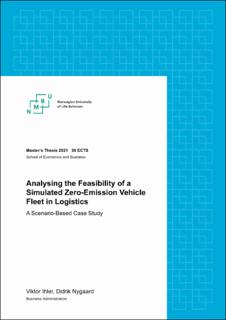| dc.description.abstract | As logistics providers strive to reduce their operational emissions with increasing urgency, the feasibility and costs associated with transitioning to zero-emission vehicle fleets is of growing concern. Meanwhile, vehicle routing problems, a staple in the field of operational research, struggle to capture the wide range of real-world complexities known to impact the operation of electric commercial vehicles to problems similar in size to those faced by commercial enterprises. The purpose of this thesis is to demonstrate how a pragmatic formulation of a Capacitated Electric Vehicle Routing Problem with Time Windows can constitute a viable decision-making tool for logistics providers seeking to eliminate operational emissions. Our two-stage solution contributes to the existing literature by enabling the incorporation of a wide range of real-world factors to large problem instances, while maintaining relatively low computational complexity.
The viability of our method is demonstrated using a Norwegian logistics provider, Bring Home Delivery, as a case study. Using historical order data to generate problem instances, we examine the feasibility and operational costs of fulfilling different levels of demand using an electric vehicle fleet. To enable comparative analyses to the case study subject’s current operations, the same problem set is solved as a conventional routing problem using a diesel vehicle fleet. By first optimizing routes for minimal operational cost and incorporating the necessary use of charging infrastructure in a subsequent step, the model is successfully applied to problem instances containing up to 648 customer nodes and 731 charging locations.
Based on our findings, we conclude that an electric vehicle fleet is a viable alternative to diesel vehicles in all scenarios, incurring operational costs similar to, or below, the costs of a diesel vehicle fleet. However, deliveries to remote areas of the largest customer network are deemed infeasible due to a combination of limited vehicle range, unavailability of charging infrastructure, and long charging times. Furthermore, the feasibility and operational costs of the solutions using electric vehicles are far more sensitive to changes in variables such as ambient temperatures or customer density than those of their diesel counterparts. | en_US |

